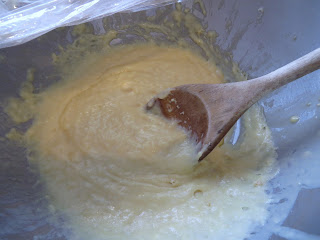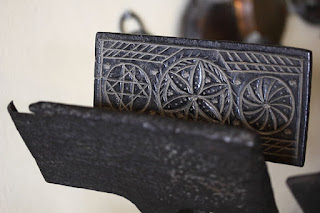Historical Food Fortnightly 2016 Challenge 3:
History Detective
The Challenge: History Detective
For this challenge, you get to be the detective! Either use clues from multiple recipes to make a composite recipe, or choose a very vague recipe and investigate how it was made.
For this challenge, you get to be the detective! Either use clues from multiple recipes to make a composite recipe, or choose a very vague recipe and investigate how it was made.
The History:
I knew that I needed to look far back in time for a vague recipe. While browsing Foodtimeline.org for inspiration, I came across a somewhat vague early recipe for one of my favorite foods - waffles!
The recipe from 1683
[1683]
"To Fry Waffles
For each pound [one English pound, or 454 grams] of Wheat-flour take a pint [about a half a litre] of sweet Milk, a little tin bow, of melted Butted with 3 or 4 Eggs, a spoonful of Yeast well stirred together."
---De Verstandige Kock (The Sensible Cook) [Netherlands ,
1683?], Translated and Edited by Peter G. Rose [Syracuse
University Syracuse ]
1989 (p. 76)
"To Fry Waffles
For each pound [one English pound, or 454 grams] of Wheat-flour take a pint [about a half a litre] of sweet Milk, a little tin bow, of melted Butted with 3 or 4 Eggs, a spoonful of Yeast well stirred together."
---De Verstandige Kock (The Sensible Cook) [
The earliest recipe for waffles I came across in English is from 1725
 |
Court cookery: or, The compleat English cook
By Robert Smith 1725
|
"Take Flower, Cream, Sack, Nutmeg, Sugar, Eggs, Yeast, of what
Quantity you will ; mix these to a Batter and let them stand to rise; then add
a little melted Butter and bake one to try ; if they burn, add more Butter: Melt
Butter with Sack refin'd Sugar and Orange Flower Water for the Sauce."
I then set about learning how to make yeast-raised waffles and the history of waffles.The short history is :
Waffles were a thin yeast-leavened tea cake or dessert popular through the 19th century. As leavening agents (cream of tartar, baking soda and baking powder) and modern appliances were introduced, waffles became easier to make. I concluded from the rich ingredients in these early recipes that "ye olde" waffles weren't your typical diner Belgian waffle but something more like a European Belgian waffle known as Gaufres. They were baked in irons over an open fire. The two pieces of the waffle iron fit more closely together than a typical modern waffle iron.
| Waffle iron from Wikipedia |
Français : Moule à gaufres, Musée Lorrain (Musée des Arts et Traditions populaires)
English: Waffle iron, Musée Lorrain (Popular Arts and Traditions Museum)
|
Jessup Whitehead in The American Pastry Cookbook (1894) explains:
"Goffers are gaufres, and they are wafers or thin cakes, whence
waffles which are, or used to be, called also soft wafers. But thin cakes were of
more than one sort. Almond gaufres and some others area kind of candy cakes thin
and crisp. Flemish gaufres are our waffles but made so rich that they are used as
a pastry dish for dinner with jellies and marmalades. They are also used in all
their richness for breakfast, where expense is no object but can hardly come
under the head of breakfast bread in ordinary.
Flemish Waffles or Gaufres Very rich and delicate when
directions are followed. "
You can read more about the history of waffles at The Historic Foodie and Manuscript Cookbooks Survey and read a history in French or see more images of antique waffle irons at La Cuisine Francasie D'Antan
How did you make it:
I chose to combine the original English recipe and the original Dutch recipe. I used Chef Peter Rose's modern adaption as a guide for measurements and cut that in half.
Eliza Leslie offered a similar recipe to the early Dutch one:
Eliza Leslie offered a similar recipe to the early Dutch one:
[1849]
"Waffles
Put two pints of rich milk into separate pans. Cut up and melt in one of them a quarter of a pound of butter, warming it slightly; then, when it is melted, stir it about, and set it away to cool. Beat eight eggs till very light, and mix them gradually into the other pan of milk, alternately with half a pound of flour. The mix it by degrees the milk that has the butter in it. Lastly, stir in a large table-spoonfull of strong fresh yeast. Cover the pan and set it near the fire to rise. When the batter is quite light, heat your waffle-iron, by putting it among the coals of a clear bright fire; grease the inside with butter tied in a rag, and then put in some batter. Shut the iron closely, and when the waffle is done on one side, turn the iron on the other. Take the cake out by slipping a knife underneath; and then heat and grease the iron for another waffle. Send them to table quite hot, four or six on a plate; having buttered them and strewed over each a mixture of powdered cinnamon, and white sugar. Or you may send the sugar and cinnamon in a little glass bowl."
---Directions for Cookery in its Various Branches, Miss Leslie [Philadelphia , 1849]. (p. 359)
"Waffles
Put two pints of rich milk into separate pans. Cut up and melt in one of them a quarter of a pound of butter, warming it slightly; then, when it is melted, stir it about, and set it away to cool. Beat eight eggs till very light, and mix them gradually into the other pan of milk, alternately with half a pound of flour. The mix it by degrees the milk that has the butter in it. Lastly, stir in a large table-spoonfull of strong fresh yeast. Cover the pan and set it near the fire to rise. When the batter is quite light, heat your waffle-iron, by putting it among the coals of a clear bright fire; grease the inside with butter tied in a rag, and then put in some batter. Shut the iron closely, and when the waffle is done on one side, turn the iron on the other. Take the cake out by slipping a knife underneath; and then heat and grease the iron for another waffle. Send them to table quite hot, four or six on a plate; having buttered them and strewed over each a mixture of powdered cinnamon, and white sugar. Or you may send the sugar and cinnamon in a little glass bowl."
---Directions for Cookery in its Various Branches, Miss Leslie [
I was also inspired by Jessup Whitehead's recipes, cutting the recipe in half for a quarter the quantity of hotel waffles. I used dry yeast and electric appliances including a modern electric waffle iron. I also adjusted the flavors for taste and made a sauce inspired by colonial flavorings.
1 pound flour
6 ounces of sugar
14 eggs separated
Salt
1 pint of milk
1 pint of cream
1 ounce of butter melted
1 cup of brandy
Separate the eggs. Mix flour sugar and salt dry in a pan.
Beat yolks and milk together pour them in the middle and stir to a batter
smooth and without lumps. Then add the brandy and melted butter. When about to
bake whip the pint of cream to a froth and mix it in and then beat the whites
up firm and add likewise. Bake soon while the mixture is creamy and light When
the batter must stand and wait during a long meal a little baking powder should
be beaten in after the lightness of the cream and egg whites has evaporated. This makes fine pancakes as well.
I left out the brandy and added nutmeg and some orange juice to the batter of Whitehead's recipe for "Gaufres without yeast." I accidentally looked at the directions for waffles which say to beat the egg whites frothy instead of firm so I didn't beat my egg whites firm. That undoubtedly would change the texture of my pitiful waffle attempt. I ended up with something like pancake batter. I added some extra sugar to the batter to get the waffles to brown better at a lower temperature as recommended by Jessup Whitehead.
My modern interpretation of the early yeast raised waffle recipes:
4 T+ butter
1/2 c. milk
2 large eggs
1 c. flour
1/8 tsp.salt
1/3 c. sugar
1/2 tsp. dry yeast
I left out the brandy and added nutmeg and some orange juice to the batter of Whitehead's recipe for "Gaufres without yeast." I accidentally looked at the directions for waffles which say to beat the egg whites frothy instead of firm so I didn't beat my egg whites firm. That undoubtedly would change the texture of my pitiful waffle attempt. I ended up with something like pancake batter. I added some extra sugar to the batter to get the waffles to brown better at a lower temperature as recommended by Jessup Whitehead.
 |
| Guafres Without Yeast |
4 T+ butter
1/2 c. milk
2 large eggs
1 c. flour
1/8 tsp.salt
1/3 c. sugar
1/2 tsp. dry yeast
Melt butter in one pan. Heat ½ c. whole milk on the stove until lukewarm. Add melted butter to the milk. Whip 2 large eggs in the mixer until fluffy. Add milk/butter mixture to eggs. Sift flour and add salt and sugar. Poured yeast into dry ingredients. Pour wet ingredients over dry and mix. This makes a very thin batter. Leave to rise until thicker and bubbly. Stir it down. Heat electric waffle iron and spray with cooking spray. Cook your waffles according to waffle iron directions. Turn once while baking.
I then made a sauce of orange juice (instead of orange flower water), sugar and nutmeg, leaving out the sack/sherry.
How Successful Was It?:
Making yeast raised gaufres/waffles was a disaster. I could NOT get the yeast to make my liquids all foamy. After two failed attempted, I used the remaining yeast in the package and added it to the DRY ingredients. This was not entirely successful. My yeast seized up into clumps but I left the batter in the sun for about an hour and a half and it became thicker and a little bit airy. I stirred that down and turned on my waffle iron.
 |
| Gaufre yeast batter |
My waffles baked quickly. The taste is a little unusual - more like a bread than a waffle. The sauce adds some flavor and improves the taste. My parents both liked the yeast waffles a lot.
Whitehead's recipe makes a more traditional waffle taste with the added taste of nutmeg. I sprinkled the waffle with sugar and cinnamon as Eliza Leslie recommends for her waffles. These waffles tasted a little better to me and my parents couldn't tell the difference between the two. Both waffles tasted better the next day heated up with cinnamon and sugar sprinkles on top.
Time to Complete: The better part of two days (hours).
Total Cost: $13.96 plus flour and sugar, orange juice and nutmeg I had on hand.





No comments:
Post a Comment
Leave comments and or suggestions for QNPoohBear, the modern bluestocking.